Margaret Agnew was born in 1820 in Belfast, Northern Ireland, the daughter of James Agnew.
At the age of 18 she was convicted of larceny (theft) and sentenced to transportation for seven years across the seas. (Australian Convict Transportation Registers).

Court of Justice Glasgow Scotland
Margaret, a housemaid, was charged on 9 January 1838 in the Court of Justice in Glasgow, Scotland with stealing a chest of plums.
Her criminal report mentions that she had been charged with theft three times previously in Dumbarton, Scotland (14 miles from Glasgow).
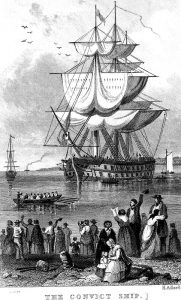
Convict Transportation ship
Margaret left Woolwich, Kent, England on 25 April 1838 aboard the convict transport ship “Nautilus” and arrived in Tasmania on 29 August 1838.
The “Nautilus” ship was built in Shields, Durham in 1833. She carried 132 female convicts to Australia on her voyage in 1838.
Aboard the ship she appears on the “Nautilus” Sick List for Female Convicts, as aged 17, received from Glasgow, health amenorrhoea (an absence of periods), months in prison-8.
In September 1838 on the Tasmanian Convict Descriptions Register she is described as Margaret Agnew, housemaid, 5 feet 3 inches, aged 18, fresh complexion, dark brown hair, brown eyes, from Belfast.
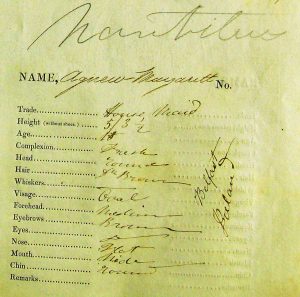
Tasmanian Convict Description – Margaret Agnew
After arrival Margaret was confined in the Female Factory in Launceston, and was convicted a few times for being absent without leave.
The Convict Muster records show she was then assigned to work for Mr A Langmead of Launceston in 1841.
She was also sent out to work for Mr Henry Clayton as a housemaid on Norfolk Plains, about 26 kms south of Launceston.
Margaret obtained her Ticket of Leave on 26 July 1843, with notice of her new found freedom appearing in the local newspapers.
Her Convict Conduct Record from the Tasmanian Archives makes for interesting reading-
 1 Sept 1838 Transported “Nautilis”, trial at Glasgow Court of Justice 9 January 1838 for seven years. Transported for theft habit and refute on previous convictions, bad connections, single state, first offence was theft of a chest of plums, convicted three times at Dunbarton for theft.
1 Sept 1838 Transported “Nautilis”, trial at Glasgow Court of Justice 9 January 1838 for seven years. Transported for theft habit and refute on previous convictions, bad connections, single state, first offence was theft of a chest of plums, convicted three times at Dunbarton for theft.
11 Jan 1840 Insubordination, sent to House of Correction. Female Factory in Launceston.
22 Jan 1841 Absent without leave.
April 1841 absent without leave, history of insolence.
Nov 1841 refusing to work, insolence to her mistress.
April 1842 misconduct, three months hard labour.
In 1842 Margaret was sent to work in the service of Mr John Jones, West Tamar. She was charged with absconding from his residence on 25 July 1842. (VDL Abscondings 1802-1853 Tasmanian Archives).
She was returned to the Female Factory, but was captured again after absconding on 18 August 1846.

St Lukes, Campbelltown, Tas
Margaret married fellow convict Henry Aldred / Aldridge on June 1844 at Cambelltown in Tasmania. Click on Henry’s name to read his story.
Henry was a convict from Leeds, in Yorkshire, convicted of housebreaking in York on 27 August 1832, found guilty, and he was sentenced to death.
His sentence was commuted to life transportation and he arrived in Tasmania on the “John” in December 1833.
Before Margaret and Henry were allowed to marry, they needed to apply for Permission to Marry from the Governor which they did, and it was approved on 17 May 1844.
Neither Henry or Margaret could write, given they signed their mark with an ‘x’. Their witnesses John and Mary Wilson did likewise.
Before the following year was up they had started their family of four children –
- George b 1845 Campbelltown, Tas d 1918 Violet Town marr *Kate White
- Elizabeth b 1850 Launceston, Tas d 1928 Violet Town marr ^Thomas Ramage
- Margaret b 1853 Benalla, Vic d 1936 Wangaratta marr #Abel White
- Ann b 1855 Violet Town, Vic d 1940 Violet Town marr ^James Ramage
*Kate’s parent’s Richard White and Emma Smith are my 3 x great grandparents.
# Abel White is Kate’s cousin – their father’s Richard and William were brothers.
^ James and Thomas Ramage were brothers – two brothers married two sisters.
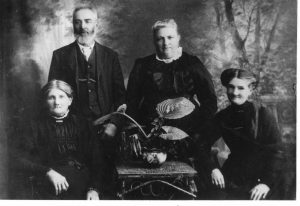
George Aldridge and sisters Margaret (standing) Elizabeth (left) Margaret (right)
In 1846 Margaret obtained her Certificate of Freedom, allowing her to move around the colony of Australia, and travel interstate.
Sometime between 1850 and 1853, after the birth of their first son George, they sailed to Melbourne, Victoria.
Their daughter Margaret was born in Benalla in 1853, but Henry and Margaret decided to make Violet Town their home, and in June 1857, Henry Aldridge, residing in Tulip Street, a bushman, appears in a survey of the town by Mrs Hoskins of the Violet Town General Store).
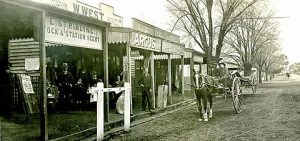
Cowslip Street Violet Town
It appears while Henry was off working around the district as a labourer, wood splitter and bushman, Margaret may have been living in Violet Town, getting herself in and out of trouble. She appears several times over the next few years at the Violet Town Police Court.
On 24 December 1867 – Mr Thomas Harrington and Mrs Margaret Aldridge were brought before the Court charged with grossly indecent conduct. They were sentenced, Harrington to two months and Margaret Aldridge to four months hard labour (Ovens & Murray Advertiser).
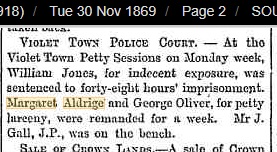
30 November 1869 – Margaret Aldridge and George Oliver were convicted of petty larceny, and were remanded for a week. (Ovens and Murray Advertiser 30 Nov 1869).
10 December 1869 – Margaret Aldridge, charged with larceny (theft), bailed, and committed for trial at Beechworth.
28 Jan 1870 – Beechworth General Sessions Trial – Margaret Aldridge charged with larceny and receiving (of one pound), found guilty, sentenced to three months in prison.
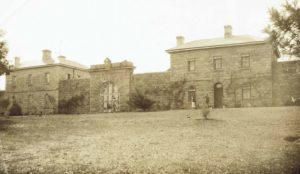
Old Beechworth Gaol
16 January 1874 – Violet Town Police Court, charged with being drunk and disorderly.
In 1875 Margaret appears in the Victorian Police Gazette, in the section entitled Prisoners reported as discharged from Penal Establishments during the week ended 6 September 1875. It provides the following information –
Beechworth Gaol, Margaret Aldridge, tried at Violet Town, 10 Mar 1875, Offence – illegally being on premises and wilful damage, sentence 6 months, birthplace Ireland, occupation servant, birthdate 1820, height 5 ft 4, complexion sallow, hair brown to grey, eyes hazel, long nose, medium mouth and chin, Remarks – two former convictions.
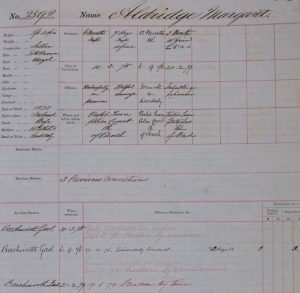
Victorian Prison Register File – Margaret Aldridge
So now Margaret has a Victorian Prisoner Record – Margaret Aldridge, born 1820 Ireland, Roman Catholic, read only, unlawfully entering premises and wilful damage.
Violet Town Police court, 7 days and fine. 3 previous convictions.
Freedom by remission 24 Aug 1875. (Public Record Office of Victoria).
16 November 1875 – Margaret Aldridge, better known as Violet Town Mag, for being drunk and disorderly, was let off with a caution, and 63 6d costs. (Ovens and Murray Advertiser).
24 July 1877 – Victorian Prison Register – Margaret Aldridge, drunk and disorderly, 12 months gaol, freedom by remission (Public Record Office of Victoria).
19 May 1879 – Victorian Prison Register – Margaret Aldridge – charged with insulting behaviour, Violet Town petty law court, 3 months and fined 5 pounds, freedom by time . (Public Record Office of Victoria).
6 October 1893 – Margaret Aldridge v. Elizabeth Ramage, illegal detention of goods to the value of £1 10s. (Euroa Advertiser Newspaper).
Margaret died in Violet Town on 25 August 1897 aged 77 years. Her husband Henry died on 1st June 1893 in Violet Town, aged 77 years.
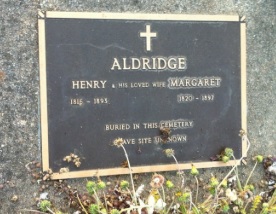
Violet Town Cemetery
They were both buried in the Violet Town Cemetery in an unknown location, but this plaque marks their burial in the cemetery.
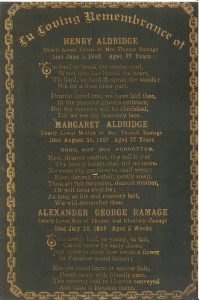
Henry and Margaret Aldridge Memorial Card

